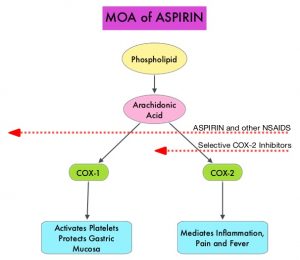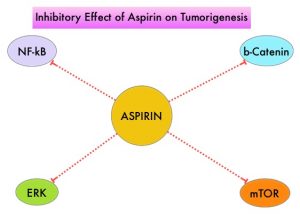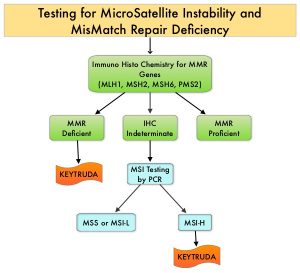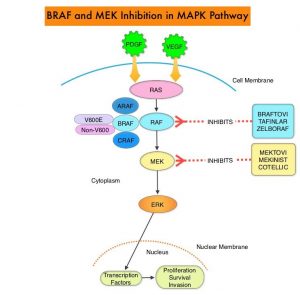SUMMARY: Colorectal Cancer (CRC) is the third leading cause of cancer-related deaths in men and women in the United States. The American Cancer Society estimates that approximately 149,500 new cases of CRC will be diagnosed in the United States in 2021 and about 52,980 patients will die of the disease. The lifetime risk of developing CRC is about 1 in 23. Colorectal Cancer is a heterogeneous disease classified by its genetics, and even though the overall death rate has continued to drop, deaths from CRC among people younger than 55 years have increased 1% per year from 2008 to 2017, with 12% of CRC cases diagnosed in people under age 50. Approximately 15-25% of the patients with CRC present with metastatic disease at the time of diagnosis (synchronous metastases) and 50-60% of the patients with CRC will develop metastatic disease during the course of their illness.
First line treatment of metastatic CRC include Oxaliplatin or Irinotecan, in combination with a Fluoropyrimidine ( FOLFOX or FOLFIRI), along with a VEGF targeting agent such as Bevacizumab or EGFR targeting agents such as Cetuximab and Panitumumab. However numerous studies have failed to clearly establish that any of these combination regimens would be superior for any given patient based on clinical factors. In the TRIBE2 Phase III study, upfront FOLFOXIRI plus Bevacizumab and reintroduction after progression resulted in significant improvement in median Overall Survival (OS), compared to mFOLFOX6 plus Bevacizumab followed by FOLFIRI plus Bevacizumab, in patients with metastatic CRC. Majority of patients with mCRC receive FOLFOX-based first-line treatment, even though neuropathy almost always limits its use beyond 4 months. Oxaliplatin has also become a first line treatment option as part of FOLFOXIRI in mCRC, as part of FOLFIRINOX in advanced Pancreatic cancer and as a part of FOLFOX for other cancers such as GE Junction and Gastric cancer. A biomarker predicting the relative efficacy of these regimens is presently lacking. However, the availability of large, combined clinical and molecular datasets has enabled the development of a machine-learning approach.
The authors conducted this study to determine a patients’ likelihood of benefit from first-line treatment with FOLFOX followed by FOLFIRI versus FOLFIRI followed by FOLFOX, by taking advantage of an advanced machine-learning approach, to identify a molecular signature (FOLFOXai), predictive of treatment benefit from FOLFOX chemotherapy, by analyzing a combined dataset of comprehensive molecular profiling results and clinical outcomes data.
The researchers leveraged AI algorithms and comprehensive molecular profiling data to develop a machine-learning approach, and identified a 67-gene molecular signature (FOLFOXai), predictive of clinical benefit from FOLFOX chemotherapy, in previously untreated patients with mCRC. The molecular signature included genes involved in mediating WNT signaling (BCL9 and CDX2), epithelial-to-mesenchymal transition (EMT; INHBA, PRRX1, PBX1, and YWHAE), chromatin remodeling (EP300, ARID1A, SMARC4, and NSD3), DNA repair (WRN and BRIP1), NOTCH signaling (MAML2), and cell-cycle regulation (CNTRL and CCNE1). They then validated the putative molecular signature from a large Real World Evidence (RWE) database, a subset of cases from the randomized controlled Phase III TRIBE2 study, as well as RWE data from patients with advanced Esophageal/Gastro Esophageal Junction cancers (EC/GEJ cancers) or Pancreatic Ductal AdenoCarcinoma (PDAC) who received first-line treatments with Oxaliplatin-containing regimens.
The researchers utilized Real World Evidence (RWE) outcomes dataset from the Caris Life Sciences Precision Oncology Alliance registry, and insurance claims data from more than 10,000 physicians. The training cohort or dataset included patients who had a diagnosis of mCRC, received treatment with FOLFOX-based combination therapy, completed at least one full cycle of therapy, and completed Next-Generation DNA analysis of at least one colorectal cancer sample using a 592-gene panel. Patients were excluded if they had prior chemotherapy, including adjuvant therapy.
Two separate RWE validation cohorts were also generated, and patients in these cohorts had a diagnosis of mCRC, received first-line treatment with FOLFOX/Bevacizumab (FOLFOX/Bevacizumab cohort) or FOLFIRI-based treatment (FOLFIRI cohort), completed at least one full cycle of therapy, completed Next-Generation DNA analysis of at least one CRC sample using a 592-gene panel, and switched to an Irinotecan-containing regimen (FOLFOX/bevacizumab cohort) or to FOLFOX (FOLFIRI cohort).
For algorithm training, a TTNT (Time To Next Treatment) of 270 days was chosen to define whether a patient benefitted from receiving first-line FOLFOX. Patients with TTNT of less than 270 days were referred to as having decreased benefit to FOLFOX and others were referred to as having increased benefit. Validation studies used Time To Next Treatment (TTNT), Progression Free Survival (PFS), and Overall Survival (OS) as the primary endpoints.
A total of 105 patients with mCRC from the RWE dataset who had received first-line FOLFOX-based treatment and who had been profiled by Caris Life Sciences, were included in the training cohort. The first validation cohort included 412 patients (with RWE data on treatments and death dates) treated with FOLFOX/Bevacizumab and 55 patients who had received FOLFIRI as first-line treatments. Additional RWE datasets included 333 patients with advanced PDAC and EC/GEJC treated in first line with Oxaliplatin-containing regimens, and blinded retrospective-prospective analysis of samples from patients enrolled in the Phase III TRIBE2 study, with completed Next Generation Sequencing (NGS) analysis.
The researchers noted that
1) A 67-gene signature was cross-validated in a training cohort (N=105) which demonstrated the ability of FOLFOXai to distinguish FOLFOX-treated patients with mCRC with increased benefit from those with decreased benefit.
2) The gene signature was predictive of TTNT and OS in an independent RWE dataset of 412 patients who had received FOLFOX/bevacizumab in first line and inversely predictive of survival in RWE data from 55 patients who had received first-line FOLFIRI.
3) Blinded analysis of TRIBE2 samples confirmed that FOLFOXai was predictive of overall survival in both Oxaliplatin-containing arms (FOLFOX HR=0.629; P=0.04 and FOLFOXIRI HR=0.483; P=0.02).
4) FOLFOXai was also predictive of benefit from Oxaliplatin-containing regimens in advanced Esophageal/Gastro Esophageal Junction cancers, as well as Pancreatic Ductal AdenoCarcinoma.
It was concluded from this analysis that application of FOLFOXai molecular signature could lead to improvements of treatment outcomes for patients with mCRC and other cancers, because patients predicted to have less benefit from Oxaliplatin-containing regimens might benefit from alternative regimens, thus providing critical guidance for the choice of first line therapy. The authors added that this is the first clinically validated, machine-learning powered molecular predictor of chemotherapy efficacy in these diseases, with immediate relevance for the initial therapeutic decision-making process.
Clinical Validation of a Machine-learning–derived Signature Predictive of Outcomes from First-line Oxaliplatin-based Chemotherapy in Advanced Colorectal Cancer. Abraham JP, Magee D, Cremolini C, et al. Clin Cancer Res 2021;27:1174-1183.





